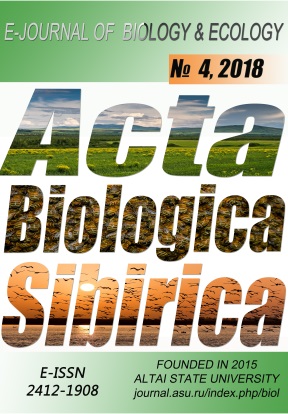Abstract
Algal-bacterial associations were studied in unialgal xenic cultures of Synedra acus subsp. radians, Asterionella formosa and Fragillaria crotonensis planktonic diatoms from Lake Baikal, using epifluorescent and scanning electron microscopy. It was found that rod- and ovoid-shaped bacteria colonized cell walls of diatoms. Cloning and sequencing of fragments of 16S rRNA gene in diatom cultures revealed members of Gammaproteobacteria (Pseudomonas sp.), Betaproteobacteria (Janthinobacterium sp., Hydrogenophaga sp., Methylophilus sp.), Bacteroidetes (Flavobacterium sp., Pedobacter sp.), and Acinobacteria (Nocardioides sp.).
References
Armbrust, E.V. (2009). The life of diatoms in the world’s oceans. Nature, 459, 185–192.
Azam, F., Malfatti, F. (2007). Microbial structuring of marine ecosystems. Nature Reviews Microbiology, 5, 782–791.
Bagatini, I.L., Eiler, A., Bertilsson, S., Klaveness, D., Tessarolli, L.P., Vieira, A.A.H. (2014). Host-specificity and dynamics in bacterial communities associated with bloom-forming freshwater phytoplankton. PloS ONE, 9(1), e85950.
Bruckner, C.G., Bahulikar, R., Rahalkar, M., Schink, B., Kroth, P. (2008). Bacteria associated with benthic diatoms from Lake Constance: phylogeny and influences on diatom growth and secretion of extracellular polymeric substances. Applied and Environmental Microbiology, 74(24), 7740–7749.
Buchan, A., LeCleir, G.R., Gulvik, C.A., González, J.M. (2014). Master recyclers: features and functions of bacteria associated with phytoplankton blooms. Nature Reviews Microbiology, 12, 686–698.
Cole, J.J. (1982). Interactions between bacteria and algae in aquatic ecosystems. Annual Review of Ecology and Systematics, 13, 291–314.
Croft, M.T., Lawrence, A.D., Raux-Deery, E., Warren, M.J., Smith, A.G. (2005). Algae acquire vitamin B12 through a symbiotic relationship with bacteria. Nature, 438, 90–93.
Denisova, L.Y., Bel’kova, N.L., Tulokhonov, I.I., Zaichikov, E.F. (1999). Bacterial diversity at various depths in the southern part of Lake Baikal as revealed by 16S rDNA sequencing. Microbiology, 68(4), 475–483.
Gärdes, A., Iversen, M.H., Grossart, H.P., Passow, U., Ulrich, M.S. (2011). Diatom-associated bacteria are required for aggregation of Thalassiosira weissflogii. The ISME Journal, 5, 436–445.
Grossart, H.-P., Levold, F., Allgaier, M., Simon, M., Brinkhoff, T. (2005). Marine diatom species harbour distinct bacterial communities. Environmental Microbiology, 7(6), 860–873.
Guannel, M.L., Horner-Devine, M.C., Rocap, G. (2011). Bacterial community composition differs with species and toxigenicity of the diatom Pseudo-nitzschia. Aquatic Microbial Ecology, 64, 117–133.
Inoue, H., Nojima, H., Okayama, H. (1990). High efficiency transformation of Escherichia coli with plasmids. Gene, 96(1), 23–28.
Marmur, J. (1961). A procedure for the isolation of deoxyribonucleic acid from micro-organisms. Journal of Molecular Biology, 3(2), 208–218.
Mikhailov, I.S., Zakharova, Y.R., Galachyants, Y.P., Usoltseva, M.V., Petrova, D.P., Sakirko, M.V., Likhoshway, E.V., Grachev, M.A. (2015). Similarity of structure of taxonomic bacterial communities in the photic layer of Lake Baikal’s three basins differing in spring phytoplankton composition and abundance. Doklady Biochemistry Biophysics, 465, 413–419.
Mila, K.S., Adrien, V., Carine, P., Sophie, F.S., Laura, P., Pierre, H., Gérald, G., Yizhi, Z., Jean‐François, S., Jean‐Michel, C., Guillaume, B. Brigitte, G. (2018). Exploring the microbiome of the “star” freshwater diatom Asterionella formosa in a laboratory context. Environmental microbiology, 20(10), 3601-3615, doi: 10.1111/1462-2920.14337.
Popovskaya, G.I., Usol’tseva, M.V., Domysheva, V.M., Sakirko, M.V., Blinov, V.V., Khodzher, T.V. (2015). The spring phytoplankton in the pelagic zone of Lake Baikal during 2007‒2011. Geography and Natural Resources, 36(3), 253–262
Porter, K.G., Feig, Y.S. (1980). The use of DAPI for identifying and counting aquatic microflora. Limnology and Oceanography, 25(5), 943–948.
Riemann, L., Steward, G.F., Azam, F. (2000). Dynamics of bacterial community composition and activity during a mesocosm diatom bloom. Applied and Environmental Microbiology, 66(2), 578–587.
Safonova, T.A., Aslamov, I.A., Basharina, T.N., Chenski, A.G., Vereschagin, A.L., Glyzina, O.Y., Grachev, M.A. (2007). Cultivation and automatic counting of diatom algae cells in multi-well plastic plates. Diatom Research, 22(1), 189–195.
Sapp, M., Schwaderer, A.S., Wiltshire, K.H., Hoppe, H.-G., Gerdts, G., Wichels, A. (2007a). Species-specific bacterial communities in the phycosphere of microalgae? Microbial Ecology, 53, 683–699.
Sapp, M., Wichels, A., Gerdts, G. (2007b). Impacts of cultivation of marine diatoms on the associated bacterial community. Applied and Environmental Microbiology, 73(9), 3117–3120.
Schäfer, H., Abbas B., Witte H., Muyzer, G. (2002). Genetic diversity of ‘satellite’ bacteria present in cultures of marine diatoms. FEMS Microbiology Ecology, 42, 25–35.
Seymour, J.R., Amin, S.A., Raina, J.-B., Stocker, R. (2017). Zooming in on the phycosphere: the ecological interface for phytoplankton–bacteria relationships. Nature microbiology, 2(7), 17065.
Sison-Mangus, M.P., Jiang, S., Tran, K.N., Kudela, R.M. (2014). Host-specific adaptation governs the interaction of the marine diatom, Pseudo-nitzschia and their microbiota. The ISME Journal, 8, 63–76.
Zakharova, Y.R., Adel’shin, R.V., Parfenova, V.V., Bedoshvili, Y.D., Likhoshway, Y.V. (2010). Taxonomic characterization of the microorganisms associated with the cultivable diatom Synedra acus from Lake Baikal. Microbiology, 79(5), 679–687.
Acta Biologica Sibirica is a golden publisher, as we allow self-archiving, but most importantly we are fully transparent about your rights.
Authors may present and discuss their findings ahead of publication: at biological or scientific conferences, on preprint servers, in public databases, and in blogs, wikis, tweets, and other informal communication channels.
ABS allows authors to deposit manuscripts (currently under review or those for intended submission to ABS) in non-commercial, pre-print servers such as ArXiv.
Authors who publish with this journal agree to the following terms:
- Authors retain copyright and grant the journal right of first publication with the work simultaneously licensed under a Creative Commons Attribution License (CC BY 4.0) that allows others to share the work with an acknowledgement of the work's authorship and initial publication in this journal.
- Authors are able to enter into separate, additional contractual arrangements for the non-exclusive distribution of the journal's published version of the work (e.g., post it to an institutional repository or publish it in a book), with an acknowledgement of its initial publication in this journal.
- Authors are permitted and encouraged to post their work online (e.g., in institutional repositories or on their website) prior to and during the submission process, as it can lead to productive exchanges, as well as earlier and greater citation of published work (See The Effect of Open Access).

